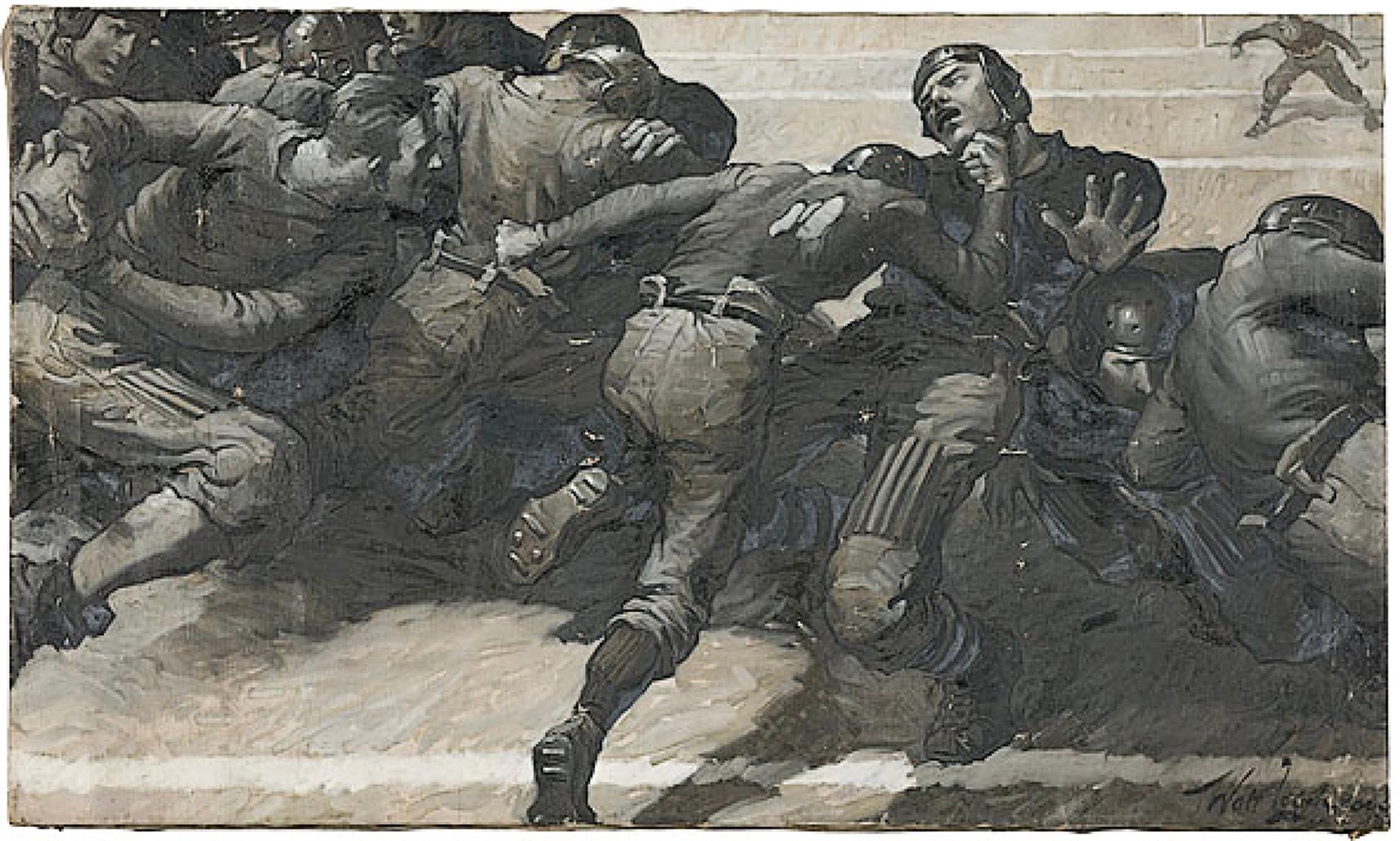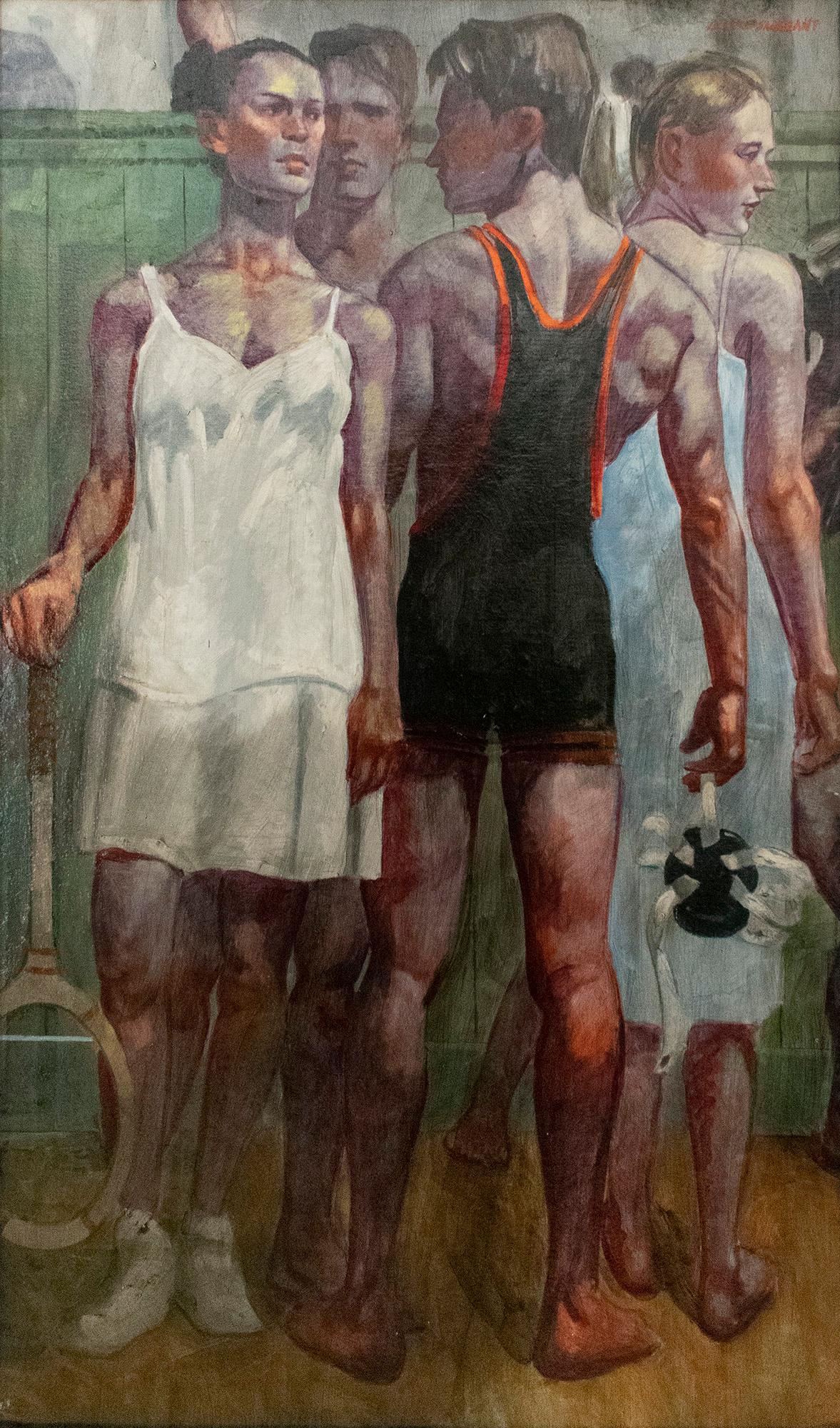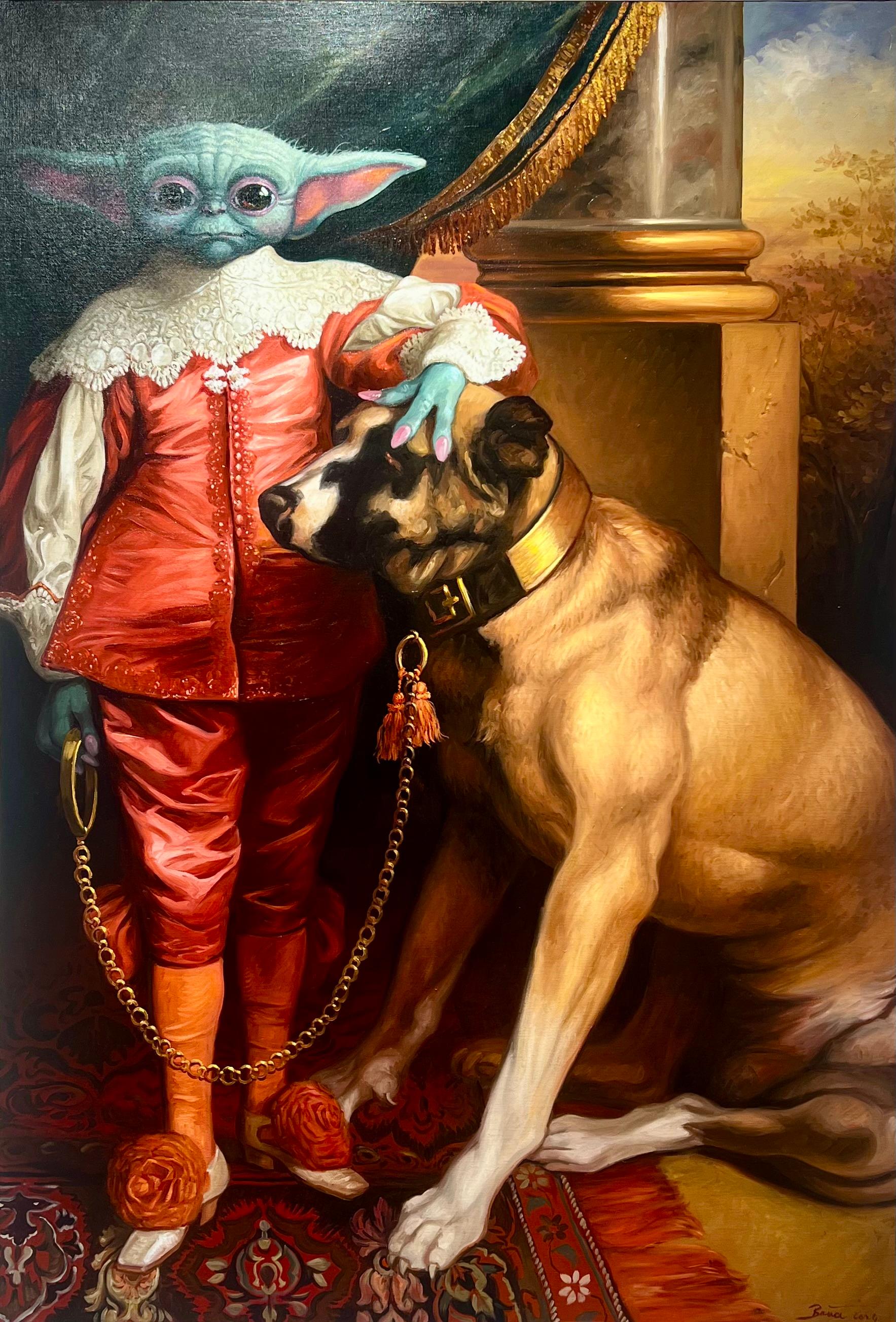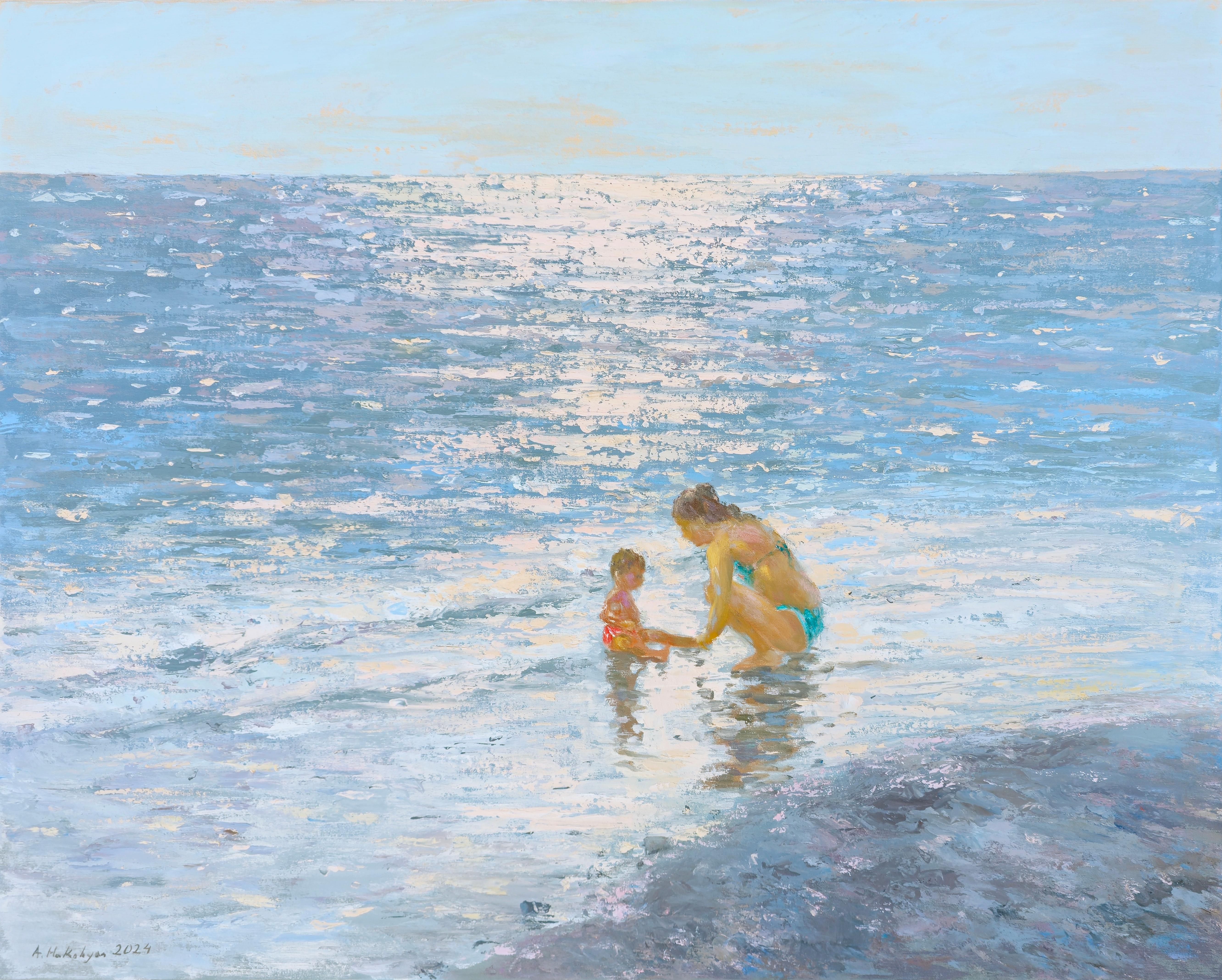Items Similar to Return Of Columbus In Chains To Cadiz By Emanuel Leutze
Want more images or videos?
Request additional images or videos from the seller
1 of 9
Emanuel LeutzeReturn Of Columbus In Chains To Cadiz By Emanuel LeutzeCirca 1842
Circa 1842
About the Item
Emanuel Leutze
1816-1868 American
Return of Columbus in Chains to Cadiz
Signed E. Leutze / Philadelphia (lower right)
Oil on canvas
Painted by the artist in 1842, this masterpiece titled Return of Columbus in Chains to Cadiz portrays Columbus in chains, surrounded by a compelling ensemble of natives, settlers and other witnesses. Leutze, renowned for his evocative and action-filled scenes from American history, imbues this masterpiece with a narrative prowess that echoes his iconic works such as Washington Crossing the Delaware. Before that work was rendered, however, there was this canvas—the very first painting he completed in America. As the composition that launched his monumental career, this painting is as historically exceptional as it is captivating.
The scene unfolds in San Domingo, present-day Dominican Republic, where Columbus awaits his return to Cadiz, Spain to endure a six-week imprisonment before being granted freedom by King Ferdinand. The arresting portrayal captures the exhaustion and tribulations faced by the renowned explorer in the aftermath of his ambitious voyages.
This masterwork stands as one of Leutze's earliest major works and once held a prominent position at the entrance to the United States Secretary of State's office. The painting's enduring significance is underscored by its selection as the image for the 1892 United States Postal Service stamp commemorating the 400th anniversary of Columbus's first visit to the Americas. A testament to its historical weight, the $2 stamp from the American Bank Note Company became a collector's item itself.
Born in Württemberg, Germany, Leutze's family emigrated to the United States in 1825 to escape religious persecution, settling in Philadelphia. His father, a staunch anti-monarchist, instilled in him a deep appreciation for democratic ideals—an ideology that would serve as the cornerstone of Leutze's celebrated career. Leutze demonstrated an early talent for art and returned to Germany to attend the prestigious Art Academy of Düsseldorf. There he was exposed to the Düsseldorf style, characterized by polished and detailed surfaces and heroic themes—a style he mastered in his depictions of America's foundation, from early explorers to later preeminent statesmen. By design his art celebrated democracy, reaching audiences worldwide.
Perhaps no other American artist can rival Emanuel Leutze's acclaim and influence. Washington Crossing the Delaware is prominently displayed in the Metropolitan Museum of Art, and the Wadsworth Atheneum showcases another of his epics, The Storming of the Teocalli by Cortez and His Troops. In 1860, Leutze painted a monumental mural for the U.S. Capitol, Westward the Course of Empire Takes Its Way, a work so impactful that it is studied in-depth at Washington, DC's Smithsonian.
Circa 1842
Canvas: 36 1/4" high x 53" wide (92.08 x 134.62 cm)
Framed: 47 5/8" high x 65" wide (120.97 x 165.10 cm)
Literature:
Bedini, Silvio A., The Christopher Columbus Encyclopedia, New York: Macmillan Publishers, 2016. Page 322.
Groseclose, Barbara S., National Collection of Fine Arts (US), 1816-1868: Freedom is the Only King, Washington, DC 1975. Page 19.
Metropolitan Museum of Art (New York, NY) American Paintings: A Catalogue of the Collection of the Metropolitan Museum of Art, 1965. Page XXVI.
Miles, Ellen Gross, Portrait Painting in America: The Nineteenth Century, Main Street: University of California Press, 1977. Page 84.
Taylor, Joshua C. The Fine Arts in America, Chicago: University of Chicago Press, 1981. Page 258.
Provenance:
Estate of Richard J. Arnold, Providence, RI
William R. Talbot, Jr., Philadelphia, PA
Masco Corporation, Detroit, MI
US Department of State, Secretary of State office
Gary Hendershott, Little Rock, Arkansas
Private Collection, Oregon
M.S. Rau, New Orleans
- Creator:Emanuel Leutze (1816 - 1868, American)
- Creation Year:Circa 1842
- Dimensions:Height: 47.63 in (120.99 cm)Width: 65 in (165.1 cm)Depth: 4.63 in (11.77 cm)
- Medium:
- Movement & Style:
- Period:
- Condition:
- Gallery Location:New Orleans, LA
- Reference Number:
About the Seller
5.0
Vetted Seller
These experienced sellers undergo a comprehensive evaluation by our team of in-house experts.
Established in 1912
1stDibs seller since 2013
15 sales on 1stDibs
Typical response time: 3 hours
- ShippingRetrieving quote...Ships From: New Orleans, LA
- Return PolicyThis item cannot be returned.
More From This SellerView All
- Au Bord Du Ruisseau By William-Adolphe BouguereauBy William-Adolphe BouguereauLocated in New Orleans, LAWilliam-Adolphe Bouguereau 1825-1905 French Au Bord du Ruisseau Signed and dated “W-Bouguereau-1888” (upper left) Oil on Canvas “Bouguereau’s paintings of children allowed for th...Category
19th Century Academic Figurative Paintings
MaterialsOil, Canvas
- Petite Mendiante By William-Adolphe BouguereauLocated in New Orleans, LAWilliam Bouguereau French 1825-1905 Petite Mendiante (Little Beggar) Signed “W. Bouguereau 1880” (center left) Oil on canvas William Bouguereau's faithful images of young women a...Category
19th Century Academic Figurative Paintings
MaterialsCanvas, Oil
- Baigneuses (Bathers)By Louis-Joseph CourtatLocated in New Orleans, LAFrench Academic painter Louis-Joseph Courtat displays his mastery of composition and the female form in this entrancing oil on canvas. Entitled Baigneuses, the work was painted for and exhibited at the 1885 Paris Salon, the foremost exhibition of painters in the Western world. Large in size, it captures two nude bathers within a tranquil beach scene. While the artist's skill for landscape painting is on display, it is his command of form, light and color that bring this canvas to life. The artist specialized in paintings that glorified the nude, and his skill is clear in the luminosity of his models' skin and the classical beauty of their form and proportions. With their soft, undulating curves and flowing hair, Courtat's models reflect the two key influences on the young painter, that of the great Jean-Auguste-Dominique Ingres as well as his teacher Alexandre Cabanel. Like these two greats who came before him, Courtat similarly follows in the artistic tradition of the female nude that is traceable to classical antiquity and the Italian Renaissance. Born in Paris in 1847, Courtat studied at the famed École des Beaux-Arts under Cabanel. He was one of the Academic master's first students at the school, where he began to teach in 1864. Displaying considerable skill at an early age, Courtat won the Prix de Rome around 1870, and subsequently studied in Rome for a number of years. He returned to Paris in 1873 to make his debut at the Salon, where he was met with immediate success, receiving a third class medal. He received medals again in 1874 and 1875, a remarkable achievement for a painter of his age. In addition to the monumental nudes...Category
19th Century Academic Nude Paintings
MaterialsCanvas, Oil
- La Danse pyrrhique (Pyrrhic Dance)By Jean-Léon GérômeLocated in New Orleans, LAThis painting by Jean-Léon Gérôme entitled La Danse pyrrhique is among the most fascinating compositions ever composed by the Academic master’s hand. Gérôme’s iconic scenes of the East captivated a generation, and this work showcases all of the artist’s unparalleled talents. Set in the Ptolemaic period of Ancient Egypt, its depiction of the ritual Pyrrhic dance is vivid and striking. Beautifully painted and rich with detail, it represents the best of Gérôme’s famed Orientalist scenes. In La Danse pyrrhique, Gérôme gives us a dramatic rendering of this ancient war dance. Greek in origin, it was performed by costumed dancers armed with swords who completed a series of movements set to music pantomiming combat. Homer wrote that Achilles performed this dance in a show of respect and grief at the funeral of his friend, Patroclus. When Julius Caesar introduced it to the Roman Games, its popularity spread across the Roman Empire to include Egypt, where Gérôme’s composition is set. Gérôme visited Egypt for the first time in 1856, and he returned throughout the late 19th century when this work was created. Gérôme’s first-hand familiarity with this setting is evident in this piece, and his visual narrative is unlike any other. His paintings combine the rationalist style of historical paintings and the theatrical...Category
19th Century Academic Figurative Paintings
MaterialsOil, Canvas
- A Pompeian LadyBy John William GodwardLocated in New Orleans, LAJohn William Godward 1861-1922 British A Pompeian Lady Signed and dated "J.W. Godward 1904" (lower right, partially covered by frame) Oil on canvas One of the last and greatest Victorian neoclassical painters, John William Godward is celebrated for his flawlessly executed images of graceful women posed in idealized ancient settings. In this work, entitled A Pompeian Lady, a classical beauty is caught idling in a moment of quiet, solitary reflection. Godward's elegant subjects are depicted with a degree of technical mastery that remains unsurpassed, and the work's dramatic palette, luxurious fabrics and classical vision are all characteristics of his unique take on the neoclassical style. Godward was unmatched in terms of his technical skill and attention to detail. A master of contrasting textures, he paints a diaphanous gown draping against the model’s smooth, milky white skin, which sits against the painstakingly rendered individual hairs of a tiger’s pel. Scintillating color permeates the canvas as well, energizing the otherwise static scene. Each element is given careful attention, and the overall effect is one of both immaculate technique and sensual tactility. Along with his contemporary and mentor, Sir Lawrence Alma-Tadema, Godward set the tone for the Victorian neoclassicist movement. He built his career upon creating images of idealized feminine beauty infused with a Greco-Roman-inspired style. Though greatly influenced by Alma-Tadema, Godward distinguished himself through his predilection for the solitary female figure. His fame rose dramatically in the first few years of the 20th century, when the present work was completed, due to the burgeoning strength of the British Empire and the Victorian society’s preoccupation with ancient Rome. To many of the newly affluent, Roman society was, as Iain Gale writes, “a flawless mirror of their own immaculate world.” The sensuality and mystery of Godward’s maidens, combined with his impressive antique backdrops...Category
Early 20th Century Academic Portrait Paintings
MaterialsOil, Canvas
- Dance of the NymphsBy Paul Desire TrouillebertLocated in New Orleans, LAThis lyrical landscape entitled Dance of the Nymphs was composed by the French Barbizon painter Paul Désiré Trouillebert. A joyful scene of nymphs dancing the morning fog, the work closely resembles an important work by the great Camille Corot, which is now housed at the Musée d'Orsay (Paris). Renowned for his unique individuality that toed the line between the traditional and modern, Corot and his landscapes helped pave the way for an entire generation of Impressionists who followed him. Trouillebert perfectly captures the poetic atmosphere of Corot’s groundbreaking works, while also imbuing this scene with a freshness and character that is all his own. Trouillebert's oil on canvas is exemplary of the tradition of historical painting. The work perfectly combines a realistic depiction of the natural world with a spirited romanticism as his idealized nymph figures frolic playfully beneath a crisp morning sky. As a whole, it is a lovely composition executed with a level of skill and artistry that proves Trouillebert's exceptional talent in the arts. Born in Paris in 1831, Paul Désiré Trouillebert was a student of the academic painters Ernest Hébert...Category
19th Century Academic Landscape Paintings
MaterialsCanvas, Oil
You May Also Like
- Old Time Football in the 1920s - Football 1920s - Classic FootballBy Walt LouderbackLocated in Miami, FLYou Got to be a Football Hero to Get Along with a Beautiful Girl. Masterfully composed and dynamic illustration that show a player getting punched in the jaw. During this period, there were no face...Category
1920s Academic Figurative Paintings
MaterialsOil, Canvas
- Tennis Whites & Wrestling Singlet (Figurative Oil of Athletes by Mark Beard)By Mark BeardLocated in Hudson, NYAcademic style figurative oil painting of a young, female tennis player and young male athlete dressed in a wrestling singlet by Mark Beard (aka Bruc...Category
Early 2000s Academic Figurative Paintings
MaterialsCanvas, Oil
- ToutouLocated in PARIS, FROriginal and unique painting by contemporary french artist Thierry Bruet. Oil on canvas. Anachronistic artwork created by Thierry Bruet, inspired by a pa...Category
2010s Academic Figurative Paintings
MaterialsCotton Canvas, Oil
- RedLocated in PARIS, FROriginal and unique painting by contemporary french artist Thierry Bruet. Oil on canvas. Anachronistic artwork created by Thierry Bruet, inspired by a pa...Category
2010s Academic Figurative Paintings
MaterialsOil, Cotton Canvas
- Love & the Jester - Oil Painting of SacrificeBy Jesus NodarseLocated in Brooklyn, NYOil Painting of a Love and Sacrafice by Cuban Artist Jesus Nordarse. Oil on Canvas. 18 x 18 inches. THE MAN: Jesús Nodarse Valdés was born in Sagua la Grande, Cuba in 1973. He studi...Category
2010s Academic Figurative Paintings
MaterialsCanvas, Oil
- Ocean Serene, Impressionism, Original oil Painting, One of a KindLocated in Granada Hills, CAArtist: Ara H. Hakobyan Work: Original Oil Painting, Handmade Artwork, One of a Kind. Medium: Oil on Canvas Year: 2024 Style: Impressionism Title: Ocean Serene Size: 31.5" x 39.5" x ...Category
2010s Academic Figurative Paintings
MaterialsCanvas, Oil
Recently Viewed
View AllMore Ways To Browse
Antique By Design
No Return
Antique Chain Styles
Antique Chain Collection
Major Taylor
19century Fine Art
Antique Frames Chicago
Brown University Antique
Washington Stamps
Antique Stamp Collectors
Barbara Grant
Dominican Art
Secretary New
Chicago Street Scene
German Wurttemberg
R King
Monumental Painting Antique
Spanish Street Scene




